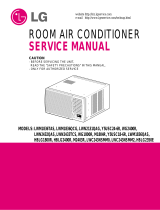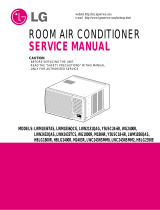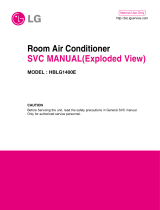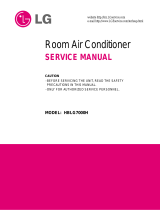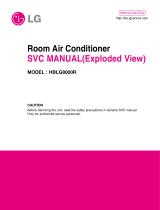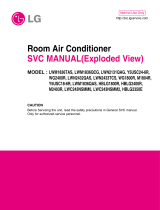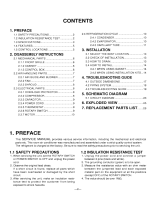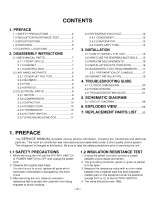Page is loading ...

Room Air Conditioner
SVC MANUAL(Exploded View)
CAUTION
Before Servicing the unit, read the safety precautions in General SVC manual.
Only for authorized service personnel.
Internal Use Only
http://biz.lgservice.com
MODEL :
LWC1031DAG/DAS, LWC1213AAS/ACG/AAG
Y5USC12-6A, LWC1232ACG/DAG/ACP/AAS/DAS
LWC1232A5S, HBLG1200H
LWC1430AAG, R1404
LWC143CSAA0

- 2 -
Copyright ©2007 LG Electronics. Inc. All right reserved.
Only for training and service purposes
LGE Internal Use Only
1. PREFACE
1.1 SAFETY PRECAUTIONS................................2
1.2 INSULATION RESISTANCE TEST .................2
1.3 SPECIFICATIONS...........................................3
1.4 FEATURES......................................................5
1.5 CONTROL LOCATIONS .................................5
2.
DISASSEMBLY INSTRUCTIONS
2.1 MECHANICAL PARTS ....................................6
2.1.1 FRONT GRILLE .....................................6
2.1.2 CABINET ................................................6
2.1.3 CONTROL BOX .....................................6
2.2 AIR HANDLING PARTS ..................................7
2.2.1 AIR GUIDE AND BLOWER ....................7
2.2.2 FAN ........................................................7
2.2.3 SHROUD ................................................8
2.3 ELECTRICAL PARTS......................................8
2.3.1 OVERLOAD PROTECTOR ....................8
2.3.2 COMPRESSOR......................................8
2.3.3 CAPACITOR...........................................9
2.3.4 POWER CORD ......................................9
2.3.5 THERMOSTAT.......................................9
2.3.6 ROTARY SWITCH .................................9
2.3.7 MOTOR ................................................10
2.4 REFRIGERATION CYCLE ............................10
2.4.1 CONDENSER.......................................10
2.4.2 EVAPORATOR.....................................10
2.4.3 CAPILLARY TUBE ...............................11
3.
INSTALLATION
3.1 SELECT THE BEST LOCATION...................13
3.2 CHECK OF INSTALLATION..........................13
3.3 HOW TO DRAIN............................................13
3.4 HOW TO INSTALL ........................................14
3.4.1 WHEN USING GASKET.......................15
3.4.2 WHEN USING INSTALLATION KITS...15
3.5 SUGGESTED TOOL REQUIREMENTS .......16
3.6 CABINET INSTALLATION.............................16
4.
TROUBLESHOOTING GUIDE
4.1 OUTSIDE DIMENSIONS ...............................18
4.2 PIPING SYSTEM...........................................19
4.3 TROUBLESHOOTING GUIDE ......................20
5. SCHEMATIC DIAGRAM
5.1 CIRCUIT DIAGRAM ......................................24
6. EXPLODED VIEW ..................................25
1. PREFACE
This
SERVICE MANUAL provides various service information, including the mechanical and electrical
parts etc. This room air conditioner was manufactured and assembled under a strict quality control system.
The refrigerant is charged at the factory. Be sure to read the safety precautions prior to servicing the unit.
1.1 SAFETY PRECAUTIONS
1. When servicing the unit, set the ROTARY SWITCH
or POWER SWITCH to OFF and unplug the power
cord.
2. Observe the original lead dress.
If a short circuit is found, replace all parts which
have been overheated or damaged by the short
circuit.
3. After servicing the unit, make an insulation resis-
tance test to protect the customer from being
exposed to shock hazards.
1.2
INSULATION RESISTANCE TEST
1. Unplug the power cord and connect a jumper
between 2 pins (black and white).
2. The grounding conductor (green) is to be open.
3. Measure the resistance value with an ohm meter
between the jumpered lead and each exposed
metallic part on the equipment at all the positions
(except OFF) of the ROTARY SWITCH.
4. The value should be over 1MΩ.
CONTENTS

- 3 -
Copyright ©2007 LG Electronics. Inc. All right reserved.
Only for training and service purposes
LGE Internal Use Only
1.3 SPECIFICATIONS
POWER SUPPLY
COOLING CAPACITY (Btu/h)
INPUT (W)
RUNNING CURRENT (A)
E.E.R (BTU/W.h)
HEATING CAPACITY (Btu/h)
INPUT (W)
RUNNING CURRENT (A)
INDOOR (°C)
OUTDOOR (°C)
REFRIGERANT (R-22) CHARGE
EVAPORATOR
CONDENSER
FAN, INDOOR
FAN, OUTDOOR
FAN SPEEDS, FAN/COOLING/HEATING
FAN MOTOR
OPERATION CONTROL
ROOM TEMP. CONTROL
AIR DIRECTION CONTROL
CONSTRUCTION
ELECTRIC HEATER
COMPRESSOR
PROTECTOR FAN MOTOR
ELECTRIC HEATER
POWER CORD
DRAIN SYSTEM
NET WEIGHT (lbs/kg)
OUTSIDE DIMENSION (inch)
(W xH xD) (mm)
1Ø,230V,60Hz 1Ø,220V,60Hz 1Ø,208/230V,60Hz 1Ø,220V,60Hz
10,055 12,000 11,500/12,000
1,030 1,220 1,250/1,220 1,200
5 5.5 6.2/5.5 5.8
10.3kJ/W,h 9.8 9.7
- - 11,200 9,200/11,200 -
- - 3,500 2,900/3,500 -
- - 15.3 14/15.3 -
26.7(DB)* 19.4(WB)**
35(DB)* 23.9(WB)**
510g(18.0oz) 555g(19.4oz)
2R 16S,SLIT-FIN TYPE
2R 13S,LOUVERED-FIN TYPE
2R 17S,LOUVERED-FIN TYPE
BLOWER
PROPELLER TYPE FAN WITH SLINGER-RING
2/3 2/3 1/2/2 2/3
6 POLES
ROTARY SWITCH OR ROCKER SWITCH
THERMOSTAT
VERTICAL LOUVER(RIGHT & LEFT)
HORIZONTAL LOUVER (UP & DOWN)
SLIDE IN-OUT CHASSIS
- - 3.5kW, 230V -
OVERLOAD PROTECTOR
INTERNAL THERMAL PROTECTOR
--
FUSE LINK,BINETAL THERMOSTAT -
(3 WIRE WITH GROUNDING)
ATTACHMENT PLUG(CORD-CONNECTED TYPE)
DRAIN PIPE OR SPLASHED BY FAN SLINGER
90.4/41 97/44
23
5
/8 x 14
31
/32 x 22
5
/16
600 x 380 x 567
LWC1031DAG/
DAS
LWC1232AAS/DAG
LWC1232ACG/ACP
Y5USC12-6A
LWC1232A5S HBLG1200H LWC1232DAS
MODELS
ITEMS
OPERATING
CONDITION
* DB:Dry Bulb
**
WB:Wet Bulb
NOTE: Please refer to Label Quality on the produst since this specification may be changed for improving performance.

- 4 -
Copyright ©2007 LG Electronics. Inc. All right reserved.
Only for training and service purposes
LGE Internal Use Only
POWER SUPPLY
COOLING CAPACITY (Btu/h)
INPUT (W)
RUNNING CURRENT (A)
E.E.R (BTU/W.h)
HEATING CAPACITY (Btu/h)
INPUT (W)
RUNNING CURRENT (A)
INDOOR (°C)
OUTDOOR (°C)
REFRIGERANT (R-22) CHARGE
EVAPORATOR
CONDENSER
FAN, INDOOR
FAN, OUTDOOR
FAN SPEEDS, FAN/COOLING/HEATING
FAN MOTOR
OPERATION CONTROL
ROOM TEMP. CONTROL
AIR DIRECTION CONTROL
CONSTRUCTION
ELECTRIC HEATER
COMPRESSOR
PROTECTOR FAN MOTOR
ELECTRIC HEATER
POWER CORD
DRAIN SYSTEM
NET WEIGHT (lbs/kg)
OUTSIDE DIMENSION (inch)
(W xH xD) (mm)
1Ø, 115V, 60Hz 1Ø, 220V, 60Hz 1Ø, 115V, 60Hz
12,000 14,000 14,000
1,220 1,400 1,380
11 6.2 12
9.8 10 10.1
---
---
---
26.7(DB)* 19.4(WB)**
35(DB)* 23.9(WB)**
530g(18.7oz) 670g(23.6oz) 550g(19.4oz)
2R 16S SLIT-FIN TYPE 2R 13S SLIT-FIN TYPE 2R 13S,SLIT-FIN TYPE
2R 17S LOUVERED-FIN TYPE 2R 14S LOUVERED-FIN TYPE 2R 17S,LOUVERED-FIN TYPE
TURBO FAN BLOWER TURBO FAN
PROPELLER TYPE FAN WITH SLINGER-RING
2/3
6 POLES
ROTARY SWITCH OR ROCKER SWITCH
THERMOSTAT
VERTICAL LOUVER(RIGHT & LEFT)
HORIZONTAL LOUVER (UP & DOWN)
SLIDE IN-OUT CHASSIS
-
OVERLOAD PROTECTOR
INTERNAL THERMAL PROTECTOR
-
(3 WIRE WITH GROUNDING)
ATTACHMENT PLUG(CORD-CONNECTED TYPE)
DRAIN PIPE OR SPLASHED BY FAN SLINGER
95/43 93/42
23
5
/8 x 14
31
/32 x 22
5
/16
600 x 380 x 567
LWC1213AAS/ACG/AAG LWC1430AAG R1404/LWC143CSAA0
MODELS
ITEMS
OPERATING
CONDITION
* DB:Dry Bulb
**
WB:Wet Bulb
NOTE: Please refer to Label Quality on the produst since this specification may be changed for improving performance.

- 5 -
Copyright ©2007 LG Electronics. Inc. All right reserved.
Only for training and service purposes
LGE Internal Use Only
1.4 FEATURES
• Designed for COOLING ONLY.
• Powerful and whispering cooling.
• Slide-in and slide-out chassis for the simple
installation and service.
• Side air-intake, side cooled-air discharge.
1.5 CONTROL LOCATIONS
1.5.1 COOLING ONLY MODEL
• VENTILATION
The ventilation lever must be in the CLOSE position
in order to maintain the best cooling conditions.
When a fresh air is necessary in the room, set the
ventilation lever OPEN position.
The damper is opened and room air is exhausted.
• THERMOSTAT
Thermostat will automatically control the temperature
of the room. Select a higher number for a cooler
temperature in the room. The temperature is selected
by positioning the knob to the desired position.
The 5 or 6 position is a normal setting for average
conditions.
• OPERATION
Off - Turns air conditioner off.
Med Fan - Med speed fan operation without cooling.
Low Fan - Low speed fan operation without cooling.
High Cool - Cooling with high speed fan operation.
Med Cool - Cooling with med speed fan operation.
Low Cool - Cooling with low speed fan operation.
• Built-in adjustable THERMOSTAT
• Washable one-touch filter
• Compact size
• Reliable and efficient rotary compressor is equipped.
CLOSE VENT OPEN
Thermostat
Warmer Cooler
BEFORE RESTARTING
WAIT THREE MINUTES
Operation
1
Thermostat Operation
2
3
4
9
8
7
6
5
Off
Med
Fan
Low
Fan
High
Cool
Med
Cool
Low Cool
Auto Swing
Off On
• OPERATION
Off
( ) :
Turns the air conditioner off.
Low Fan
( ) :
Permits the low fan speed operation
without cooling (heating).
Low Cool
( ) :
Permits cooling with the low fan
speed operation.
High Cool
( ) :
Permits cooling with the high fan
speed operation.
Low Heat
( ) :
Permits heating with the low fan
speed operation.
High Heat
( ) :
Permits heating with the high fan
speed operation.
• Auto Swing (For R1403/WR1210)
On: Air Swing is operated while operation knob is set to
the Cool position
Off: Stops the operation of air swing.
A slight heat odor may come from the unit when first
switching to HEAT after the cooling season is over.
This odor, caused by fine dust particles on the
heater, will disappear quickly.
❈ Panel design can differ according to the model.

- 6 -
Copyright ©2007 LG Electronics. Inc. All right reserved.
Only for training and service purposes
LGE Internal Use Only
2.1 MECHANICAL PARTS
2.1.1 FRONT GRILLE
1. Open the lnlet grille upward .
2. Remove the screw which fastens the front grille.
3. Pull the front grille from the right side.
4. Remove the front grille.
5. Re-install the component by referring to the
removal procedure, above.(See Figure 1)
2.1.2 CABINET
1. After disassembling the FRONT GRILLE, remove
the 2 screws which fasten the cabinet at both
sides.
2. Remove the 2 screws which fasten the cabinet at
back.
3. Pull the base pan forward. (See Figure 2)
4. Remove the cabinet.
5. Re-install the component by referring to the
removal procedure, above.
2.1.3 CONTROL BOX
1. Remove the front grille. (Refer to section 2.1.1)
2. Remove the cabinet. (Refer to section 2.1.2)
3. Remove the 2 screws which fasten the control box
cover.
4. Remove two housings which connect compressor
wire and motor wire in the control box.
5.Discharge the capacitor by placing a 20,000
ohmresistor across the capacitor terminals.
6. Remove the 2 screws which fasten the control
box.
7. Pull the control box forward completely.
8. Re-install the components by referring to the
removal procedure, above. (See Figure 3)
(Refer to the circuit diagram found on page 24 in
this manual and on the control box.)
1
T
h
e
rm
o
stat
O
p
era
tio
n
2
3
4
9
8
7
6
5
O
ff
M
e
d
F
a
n
L
o
w
F
a
n
H
ig
h
C
o
o
l
M
e
d
C
o
o
l
L
o
w
C
o
o
l
1
T
h
erm
o
s
ta
t
O
p
e
ra
ti
o
n
2
3
4
9
8
7
6
5
O
ff
M
e
d
Fa
n
Low
F
a
n
H
ig
h
C
oo
l
M
e
d
C
oo
l
Lo
w
C
o
o
l
1
Therm
ostat
O
peration
2
3
4
9
8
7
6
5
O
f
f
Med
Fan
Low
Fan
High
Cool
Med
Cool
Low Cool
2. DISASSEMBLY INSTRUCTIONS
— Before the following disassembly, POWER SWITCH set to OFF and disconnect the power cord.
Figure 1
Figure 3
Figure 2

- 7 -
Copyright ©2007 LG Electronics. Inc. All right reserved.
Only for training and service purposes
LGE Internal Use Only
2.2 AIR HANDLING PARTS
2.2.1 AIR GUIDE AND BLOWER
1. Remove the front grille. (Refer to section 2.1.1)
2. Remove the cabinet. (Refer to section 2.1.2)
3. Remove the control box. (Refer to section 2.1.3)
4. Remove the 4 screws which fasten the brace.
5. Remove the brace.
6. Remove the 2 screws which fasten the evaporator.
7. Move the evaporator forward and pulling it upward
slightly. (See Figure 4)
8. Move the evaporator to the left carefully.
9. Remove the 2 terminals carefully. (See Figure 5, at
Electric heater Model)
10. Remove the 3 screws which fasten the Heater
Cover. (See Figure 5, at Electric Heater Model)
11. Remove the Heater cover. (See Figure 5, at
Electric Heater Model)
12. Pull out the hook of orifice by pushing the tabs
and remove it. (See Figure 6)
13. Remove the clamp with a hand plier which
secures the blower.
14. Remove the blower.
15. Remove the 4 screws which fasten the air guide
from the barrier.
16. Move the air guide backward, pulling out from the
base pan.
17. Re-install the components by referring to the
removal procedure, above.
2.2.2 FAN
1. Remove the cabinet. (Refer to section 2.1.2)
2. Remove the brace (Refer to section 2.2.1)
3. Remove the 4 screws which fasten the condenser.
4. Move the condenser to the left carefully.
5. Remove the clamp which secures the fan.
6. Remove the fan. (See Figure 7)
7. Re-install by referring to the removal procedure.
1
T
he
rm
o
sta
t
O
peratio
n
2
3
4
9
8
7
6
5
O
ff
M
e
d
F
a
n
L
o
w
F
a
n
H
i
g
h
C
o
o
l
M
e
d
C
o
o
l
L
o
w
C
o
o
l
Figure 4
Figure 5
Figure 6
Figure 7

- 8 -
Copyright ©2007 LG Electronics. Inc. All right reserved.
Only for training and service purposes
LGE Internal Use Only
2.2.3 SHROUD
1. Remove the fan. (Refer to section 2.2.2)
2. Remove the screw which fastens the shroud.
3. Remove the shroud. (See Figure 8)
4. Re-install the component by referring to the
removal procedure, above.
2.3 ELECTRICAL PARTS
2.3.1 OVERLOAD PROTECTOR
1. Remove the cabinet. (Refer to section 2.1.2)
2. Remove the nut which fastens the terminal cover.
3. Remove the terminal cover. (See Figure 9)
4. Remove all the leads from the overload protector.
5. Remove the overload protector.
6. Re-install the component by referring to the
removal procedure, above.
2.3.2 COMPRESSOR
1. Remove the cabinet. (Refer to section 2.1.2)
2. Discharge the refrigerant system using a Freon
TM
Recovery System.
If there is no valve to attach the recovery system,
install one (such as a WATCO A-1) before venting
the Freon
TM
. Leave the valve in place after
servicing the system.
3. Remove the overload protector. (Refer to section
2.3.1)
4. After purging the unit completely, unbraze the
suction and discharge tubes at the compressor
connections.
5. Remove the 3 nuts and the 3 washers which
fasten the compressor.
6. Remove the compressor. (See Figure 10)
7. Re-install the components by referring to the
removal procedure, above.
Figure 8
Figure 9
Figure 10

- 9 -
Copyright ©2007 LG Electronics. Inc. All right reserved.
Only for training and service purposes
LGE Internal Use Only
2.3.3 CAPACITOR
1. Remove the control box. (Refer to section 2.1.3)
2. Remove the knobs and the screw which fasten
control panel from control box.
3. Remove the screw which located in the front.
4. Open the bottom side of control box.
5. Remove the screw and the clamp which fastens
the capacitor.
6. Disconnect all the leads of capacitor terminals.
7. Re-install the components by referring to the
removal procedure, above. (See Figure 11)
2.3.4 POWER CORD
1. Remove the control box. (Refer to section 2.1.3)
2. Open the control box. (Refer to section 2.3.3)
3. Disconnect the grounding screw from the control
box.
4. Disconnect the 2 receptacles.
5. Remove a screw which fastens the clip cord.
(See Figure 12)
6. Remove the power cord.
7. Re-install the component by referring to the above
removal procedure, above.
(Use only one ground-marked hole for ground
connection.)
8. If the supply cord of this appliance is damaged, it
must be replaced by the special cord. (The
special cord means the cord which has the same
specification marked on the supply cord attached
at the unit.)
2.3.5 THERMOSTAT
1. Remove the control box. (Refer to section 2.1.3)
2. Open the control box. (Refer to section 2.3.3)
3. Remove the 2 screws which fasten the thermostat.
4. Disconnect 2 leads of thermostat terminals.
5. Remove the thermostat.
6. Re-install the components by refereing to the
above removal procedure. (See Figure 13)
2.3.6 ROTARY SWITCH
1. Remove the control box. (Refer to section 2.1.3)
2. Open the control box. (Refer to section 2.3.3)
3. Remove the 2 screws which fasten the rotary
switch.
4. Disconnect all the leads of the rotary switch
terminals.
5. Remove the rotary switch.
6. Re-install the components by referring to the
above removal procedure. (See Figure 14)
Figure 12
Figure 11
Figure 13
Figure 14

- 10 -
Copyright ©2007 LG Electronics. Inc. All right reserved.
Only for training and service purposes
LGE Internal Use Only
2.3.7 MOTOR
1. Remove the cabinet. (Refer to section 2.1.2)
2. Remove the evaporator. (Refer to section 2.2.1)
3. Remove the orifice. (Refer to section 2.2.1)
4. Remove the blower. (Refer to section 2.2.1)
5. Remove the fan. (Refer to section 2.2.2)
6. Remove the control box cover and disconnect 5 or
4 wires of motor housing. (Refer to section 2.1.3)
7. Remove the 2 or 4 screws which fasten the motor
from the mount motor. (See Figure 15)
8. Remove the motor.
9. Re-install the components by referring to the
removal procedure, above.(See Figure 15)
2.4 REFRIGERATING CYCLE
2.4.1 CONDENSER
1. Remove the cabinet. (Refer to section 2.1.2)
2. Remove the 4 screws which fasten the
brace.(Refer to section 2.2.1)
3. Remove the 5 screws which fasten the condenser
and shroud.
4. After discharging the refrigerant completely,
unbraze the interconnecting tube at the condenser
connections.
5. Remove the condenser.
6. Re-install the component by referring to notes.
(See Figure 16)
2.4.2 EVAPORATOR
1. Remove the cabinet. (Refer to section 2.1.2)
2. Remove the 2 screws which fasten the evaporator.
3. Move the evaporator sideways carefully.
(Refer to section 2.2.1)
4. After discharging the refrigerant completely,
unbraze the interconnecting tube at the evaporator
connections.
5. Remove the evaporator.
6. Re-install the component by referring to notes.
(See Figure 17)
Figure 15
Figure 16
Figure 17
Discharge the refrigerant system using a
Freon
TM
Recovery System.
If there is no valve to attach the recovery
system, install one (such as a WATCO A-1)
before venting the Freon
TM
. Leave the valve in
place after servicing the system.
CAUTION

- 11 -
Copyright ©2007 LG Electronics. Inc. All right reserved.
Only for training and service purposes
LGE Internal Use Only
— Replacement of the refrigeration cycle.
1. When replacing the refrigeration cycle, be sure to
Discharge the refrigerant system using a Freon
TM
recovery System.
If there is no valve to attach the recovery system,
install one (such as a WATCO A-1) before venting
the Freon
TM
. Leave the valve in place after
servicing the system.
2. After discharging the unit completely, remove the
desired component, and unbraze the pinch-off
tubes.
3. Solder service valves into the pinch-off tube ports,
leaving the valves open.
4. Solder the pinch-off tubes with Service valves.
5. Evacuate as follows.
1) Connect the vacuum pump, as illustrated figure
18A.
2) Start the vacuum pump, slowly open manifold
valves A and B with two full turns
counterclockwise and leave the valves open.
The vacuum pump is now pulling through valves
A and B up to valve C by means of the manifold
and entire system.
3) Operate the vacuum pump for 20 to 30 minutes,
until 600 microns of vaccum is obtained. Close
valves A and B, and observe vacuum gauge for
a few minutes. A rise in pressure would
indicate a possible leak or moisture remaining in
the system. With valves A and B closed, stop
the vacuum pump.
4) Remove the hose from the vacuum pump and
place it on the charging cylinder. See figure
18B.
Open valve C.
Discharge the line at the manifold connection.
5) The system is now ready for final charging.
6. Recharge as follows :
1) Refrigeration cycle systems are charged from
the High-side. If the total charge cannot be put
in the High-side, the balance will be put in the
suction line through the access valve which you
installed as the system was opened.
2) Connect the charging cylinder as shown in figure
18B.
With valve C open, discharge the hose at the
manifold connection.
3) Open valve A and allow the proper charge to
enter the system. Valve B is still closed.
4) If more charge is required, the high-side will not
take it. Close valve A.
5) With the unit running, open valve B and add the
balance of the charge.
a. Do not add the liquid refrigerant to the Low-
side.
b. Watch the Low-side gauge; allow pressure to
rise to 30 lbs.
c. Turn off valve B and allow pressure to drop.
d. Repeat steps b. and c. until the balance of the
charge is in the system.
6) When satisfied the unit is operating correctly,
use the pinch-off tool with the unit still running
and clamp on to the pinch-off tube. Using a tube
cutter, cut the pinch-off tube about 2 inches from
the pinch-off tool. Use sil-fos solder and solder
pinch-off tube closed. Turn off the unit, allow it to
set for a while, and then test the leakage of the
pinch-off connection.
NOTES
If high vacuum equipment is used, just crack
valves A and B for a few minutes, then open
slowly with the two full turns counterclockwise.
This will keep oil from foaming and being
drawn into the vacuum pump.
2.4.3 CAPILLARY TUBE
1. Remove the cabinet. (Refer to section 2.1.2)
2. After discharging the refrigerant completely,
unbraze the interconnecting tube at the capillary
tube.(See caution above)
3. Remove the capillary tube.
4. Re-install the component by referring to notes.
CAUTION

- 12 -
Copyright ©2007 LG Electronics. Inc. All right reserved.
Only for training and service purposes
LGE Internal Use Only
Equipment needed: Vacuum pump, Charging cylinder, Manifold gauge, Brazing equipment. Pin-off tool capable
of making a vapor-proof seal, Leak detector, Tubing cutter, Hand Tools to remove components, Service valve.
A
COMPOUND GAUGE
EVAPORATOR
(LOW PRESSURE SIDE)
COMPRESSOR
CAPILLARY TUBE
CONDENSER
(HIGH PRESSURE SIDE)
SEE INSETS
BELOW
MANIFOLD
GAUGE
B
Figure 18A-Pulling Vacuum
Figure 18B-Charging
A
B
EXTERNAL
VACUUM PUMP
A
CHARGING
CYLINDER
LOW
HI
B
C

- 13 -
Copyright ©2007 LG Electronics. Inc. All right reserved.
Only for training and service purposes
LGE Internal Use Only
3. INSTALLATION
3.1 SELECT THE BEST LOCATION
1.To prevent vibration and noise, make sure the unit
is installed securely and firmly.
2.Install the unit where the sunlight does not shine
directly on the unit.
3.The outside of the cabinet must extend outward for
at least 12" and there should be no obstacles, such
as a fence or wall, within 20" from the back of the
cabinet because it will prevent heat radiation of the
condenser.
Restriction of outside air will greatly reduce the
cooling efficiency of the air conditioner.
4.Install the unit a little slanted so the back is slightly
lower than the front (about
1
/2"). This will help force
con-densed water to the outside.
5.Install the unit from the bottom about 30"~60"
above the floor level.
3.2 CHECK OF INSTALLATION
The setting conditions must be checked prior to
initial starting.
The undermentioned items are especially important
checking points when the installation is finished.
1. Grounding wire (Green or Green and Yellow) is
provided in the power cord. The green wire must
be grounded.
2. Connect to a single-outlet 15A circuit.
(or 20A circuit for Electric Heater Model)
3. To avoid vibration or noise, make sure the air
conditioner is installed securely.
4 Avoid placing furniture or draperies in front of the
air inlet and outlet.
3.3. HOW TO DRAIN
(When using drain pipe)
The air conditioner must be installed horizontally or
tilted slightly to the outside for proper water
drainage.
On exceptionally hot and humid days the air
conditioner may overflow conclensed water.
If the air conditioner is used in hot and a high
humidity zone, exchange the HOLE RUBBER
for the DRAIN PIPE.(See figure 20, figure 21.)
All side louvers of the cabinet must remain
exposed to the outside of the structure.
AWNING
COOLED AIR
HEAT
RADIATION
30"~60"
ABOUT
1
/2"
Over 20"
FENCE
BASE PAN
HOLE RUBBER
DRAIN PIPE
1
BOTTOM
2
BASE PAN
BOTTOM
Figure 20
Figure 21
Figure 19
CAUTION

- 14 -
Copyright ©2007 LG Electronics. Inc. All right reserved.
Only for training and service purposes
LGE Internal Use Only
3.4-1 HOW TO INSTALL
(Installation kit not included models)
1. Remove the screws which fasten the cabinet
at both sides and at the back.
2. Slide the unit from the cabinet by gripping the
base pan handle and pulling forward while
bracing the cabinet.
3. Remove EPS Material.
4. Slide the unit into the cabinet.
CAUTION: For security purpose, reinstall screw at
cabinet's sides.
5. Attach the front grille to the cabinet by
inserting the tabs on the grille into the tabs on the fornt
of the cabinet. Push the grille in until it snaps into
place.
6. Lift the inlet grille and secure it with a screw through
the front grille.
Shipping screws
EPS Material
Power cord
Screw
Screw

- 15 -
Copyright ©2007 LG Electronics. Inc. All right reserved.
Only for training and service purposes
LGE Internal Use Only
3.4-2 HOW TO INSTALL (Installaion kit included models)
3.4.1 WHEN USING GASKET
3.4.2 WHEN USING INSTALLATION KITS
A. WINDOW REQUIREMENTS
This unit is designed for installation in
standard double hung windows with actual opening
widths from 27" to 39".
The top and bottom window sash must open
sufficiently to allow a clear vertical opening of 16" from
the bottom of the upper sash to the window stool.
A
B
DE
F
H
2
3
1
4
2
1
A
RIGHT SIDE
HORIZONTAL
LINE
B
1
Thermostat Operation
2
3
4
9
8
7
6
5
Off
Med
Fan
Low
Fan
High
Cool
Med
Cool
Low Cool
1
Thermostat Operation
2
3
4
9
8
7
6
5
Off
Med
Fan
Low
Fan
High
Cool
Med
Cool
Low Cool
Auto Swing
Off On
Auto Swing
Off On
1. WINDOW (WIDTH-A, HEIGHT-B)
2. GASKET
3. WALL
4. DETAILS 5.1 x 30 ROUND HEAD WOOD
SCREWS
ABCDE F HI
625mm 392mm 280mm 30mm 0~25mm OVER 420mm 5~10mm -5~5mm
(24
5
/8") (15
7
/16") (11
1
/32") (1
1
/16") (0~1") (OVER 16
17
/32") (
3
/16"~
3
/8") (-
3
/16"~
3
/16")
1
2 3 4
8 9
11
765
10
13
12
NO. NAME OF PARTS Q'TY
1 FRAME CURTAIN 2
2 SILL SUPPORT 2
3 BOLT 2
4 NUT 2
5 SCREW(TYPE A) 16
6 SCREW(TYPE B) 3
7 SCREW(TYPE C) 5
8 FOAM-STRIP 1
9 FOAM-PE 1
10 UPPER GUIDE 1
11 FOAM-PE 1
12 FRAME GUIDE 2
13
WINDOW LOCKING BRACKET
1
B. INSTALLATION KITS CONTENTS
27" to 39"
16" min
Stool
Interior wall
235
/8" min
(Without frame curtain)
Offset
1
/2" to
11
/4"
Sill
Exterior

- 16 -
Copyright ©2007 LG Electronics. Inc. All right reserved.
Only for training and service purposes
LGE Internal Use Only
3.5 SUGGESTED TOOL REQUIREMENTS
SCREWDRIVER(+, -), RULER, KNIFE, HAMMER, PENCIL, LEVEL
PREPARATION OF CHASSIS
1. Remove the screws which fasten the cabinet at
both sides and at the back.
2. Slide the unit out from the cabinet by gripping the
base pan handle and pulling forward while
bracing the cabinet.
3. Remove EPS Material.
4. Cut the window sash seal to the proper length. Peel
off the backing and attach the foam-pe to the
underside of the window sash.
5. Remove the backing from the top upper guide
Foam PE and attach it to the bottom of the upper
guide .
6. Attach the upper guide onto the top of the cabinet
with 3 type A screws.
7. Insert the frame guides into the bottom of the
cabinet.
8. Insert the Frame Curtain into the upper guide
and frame guides .
9. Fasten the curtains to the unit with 4 Type A screws
at the both sides.
3.6 CABINET INSTALLATION
1. Open the window. Mark a line on center of the
window stool(or desired air conditioner location).
Carefully place the cabinet on the window stool and
align the center mark on the bottom front with the
center line marked in the window stool.
2. Pull the bottom window sash down behind the
upper guide until it meets.
NOTE:
• Do not pull the window sash down so tightly that the
movement of Frame Curtain is restricted.
Shipping screws
EPS Material
9
10
11
10
5
5
5
12
12
(Type A)
(Type A)
Upper Guide
Front Angle
Window stool
Upper guide
Window Sash
Cabinet
Frame Curtain
10
1
1
T
h
e
r
m
o
s
t
a
t
O
p
e
r
a
t
i
o
n
2
3
4
9
8
7
6
5
O
f
f
M
e
d
F
a
n
L
o
w
F
a
n
H
i
g
h
C
o
o
l
M
e
d
C
o
o
l
L
o
w
C
o
o
l
1
T
h
e
r
m
o
s
t
a
t
O
p
e
r
a
t
i
o
n
2
3
4
9
8
7
6
5
O
f
f
M
e
d
F
an
Lo
w
F
an
H
i
g
h
C
o
ol
M
e
d
Co
o
l
Lo
w
C
o
o
l
1
Therm
ostat
O
peration
2
3
4
9
8
7
6
5
O
ff
M
e
d
F
an
L
o
w
F
a
n
H
i
g
h
C
o
o
l
M
e
d
C
o
o
l
Lo
w
C
o
o
l
Figure 22
Figure 23

- 17 -
Copyright ©2007 LG Electronics. Inc. All right reserved.
Only for training and service purposes
LGE Internal Use Only
INDOOR OUTDOOR
Sill Support
Nut
Bolt
2
4
3
INDOOR OUTDOOR
12
6
7
2
5
Frame Guide
About 1/2"
Screw(Type A)
Cabinet
6
2
About 1/2"
Screw(Type B)
5
Screw(Type A)
Sill support
Sash track
Front Angle
Type C
Screw(Type B)
Sill support
3. Loosely assemble the sill support using the parts
in
Figure 24.
4. Select the position that will place the sill
support near the outer most point on sill
(See
Figure
24)
NOTE: Be careful when you install the cabinet (frame
guides
are broken easily).
5. Attach the sill support to the cabinet track hole in
relation to the selected position using
2 Type A screws in each support (See
Figure 25).
6. The cabinet should be installed with a very slight
tilt(about
1
/2") downward toward the outside (See
Figure 26).
Adjust the bolt and the nut of sill support for
balancing the cabinet.
7. Attach the cabinet to the window stool by
driving the screws (Type B: Length sixteen
millimeters and below.) through the front angle into
window stool (5/8").
8. Pull each Frame curtain properly to each window
sash track, and repeat step 2.
9. Attach each Frame curtain to the window sash by
using screws (Type C).
(See Figure 27)
Figure 24
Figure 25
Figure 26
Figure 27

- 18 -
Copyright ©2007 LG Electronics. Inc. All right reserved.
Only for training and service purposes
LGE Internal Use Only
13
8
Foam-Strip
380(14 / ")
Screw(Type A)
Screw(Type A)
Power cord
31
32
1
T
h
e
r
m
o
s
t
a
t
O
p
e
r
a
t
i
o
n
2
3
4
9
8
7
6
5
O
f
f
M
ed
Fa
n
L
o
w
F
a
n
H
ig
h
C
o
o
l
M
e
d
C
o
o
l
L
o
w
C
oo
l
1
Thermostat Operation
2
3
4
9
8
7
6
5
Off
Med
Fan
Low
Fan
High
Cool
Med
Cool
Low Cool
Auto Swing
Off On
1
Thermostat Operation
2
3
4
9
8
7
6
5
Off
Med
Fan
Low
Fan
High
Cool
Med
Cool
Low Cool
Auto Swing
Off On
4. TROUBLESHOOTING GUIDE
4.1 OUTSIDE DIMENSIONS
unit: mm(inch)
10. Slide the unit into the cabinet.(See Fig. 28)
CAUTION: For security purpose, reinstall screws(Type
A) at the cabinet's sides.
11. Cut the foam-strip to the proper length and insert
between the upper and lower window sash.
(See Fig. 29)
12. Attach the window locking bracket with a type C
screw. (See Fig. 30)
13. Attach the front grille to the cabinet by inserting the
tabs on the grille into the tabs on the front of the
cabinet. Push the grille in until it snaps into
place.(See Fig. 31)
14. Lift the inlet grille and secure it with a type A screw
through the front grille.(See Fig. 32)
Figure 28
Figure 29
Figure 30
Figure 33
Figure 32
Figure 31

- 19 -
Copyright ©2007 LG Electronics. Inc. All right reserved.
Only for training and service purposes
LGE Internal Use Only
4.2 PIPING SYSTEM
Figure 34 is a brief description of the important components and their function in what is called the refrigeration
system. This will help you to understand the refrigeration cycle and the flow of the refrigerant in the cooling cycle.
MOTOR
COMPRESSOR
OIL
(LIQUID REFRIGERANT)
CAPILLARY TUBE
OUTSIDE COOLING
AIR FOR REFRIGERANT
PASS THROUGH
SUCTION LINE
COOL LOW PRESSURE VAPOR
COOLED
AIR
COMPLETE LIQUID
BOIL OFF POINT
LIQUID
PRESSURE
DROP
ROOM AIR HEAT LOAD
VAPOR INLET
HOT
DISCHARGED
AIR
LIQUID OUTLET
HIGH PRESSURE VAPOR
LIQUID REFRIGERANT
LOW PRESSURE VAPOR
ROOM AIR CONITIONER
EVAPORATOR COILS CONDENSER COILS
CYCLE OF REFRIGERATION
CAPILLARY TUBE
COMPRESSOR
BLOWER
EVAPORATOR COIL
CONDENSER COIL
FAN
MOTOR
Figure 34

- 20 -
Copyright ©2007 LG Electronics. Inc. All right reserved.
Only for training and service purposes
LGE Internal Use Only
4.3 TROUBLESHOOTING GUIDE
In general, possible trouble is classified in two kinds.
The one is called Starting Failure which is caused from an electrical defect, and the other is ineffective Air
Conditioning caused by a defect in the refrigeration circuit and improper application.
Unit runs but poor cooling.
Ineffective Cooling
Check outdoor coil
(heat exchanger) & the fan
operation.
Check gas leakage.
Repair gas leak.
Replacement of unit if the
unit is beyond repair.
Satisfactory operation with
temperature difference of
inlet & outlet air ;
44~50°F(7~10°C)
Check heat load
increase.
Clean condenser.
Not on separate circuit.
Check inside gas
pressure.
Adjusting of refrigerant
charged.
Malfunction of compressor.
Replacement of
compressor.
Check cold air circulation
for smooth flow.
Dirty indoor coil
(Heat exchanger)
Correct above trouble
Check clogging in refrigera-
tion circuit.
Repair clogging in refrigera-
tion circuit.
Obstruction at air outlet
Clogged of air filter.
Malfunction of fan
/
